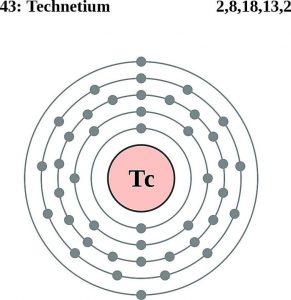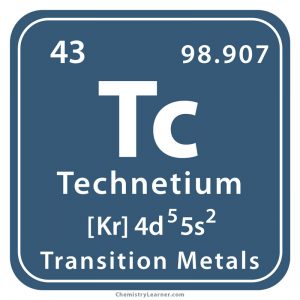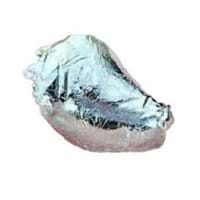Technetium
What is Technetium
A radioactive metal, technetium (pronounced as tek-NEE-she-em) is the first synthetically produced element. Denoted by the chemical symbol Tc, it belongs to the family of transition metals [1].
History
Origin of its Name: The name of the element is derived from the Greek word ‘tekhnetos’ which means artificial [1].
Who Discovered it: Carlo Perrier and Emilio Segre [1]
When and Where was it Discovered
In the 1920’s, there were claims about its discovery through spectrum analysis. However, nothing was officially confirmed.
In 1937, when Segre in Italy analyzed a molybdenum sample from California that had been subjected to powerful radiation, he isolated a new element that was later named ‘technetium’ from it [1].
Identification |
|||
| Atomic number | 43 [1] | ||
| CAS number | 7440-26-8 [1] | ||
| Position in the periodic table [1] | Group | Period | Block |
| 7 | 5 | d | |
Properties and Characteristics of Technetium
General Properties |
||
| Relative atomic mass | [98] [1] | |
| Atomic mass | 98 atomic mass units [4] | |
Physical Properties |
||
| Color/appearance | Silver [1] | |
| Melting point/freezing point | 2157°C (3915°F) [1] | |
| Boiling point | 4262°C, 7704°F [1] | |
| Density | 11 g/cm3 [1] | |
| State at standard room temperature (solid/liquid/gas) | Solid [1] | |
Chemical Properties |
||
| Oxidation state/Oxidation number | −3, −1, +1, +2, +3, +4 +5, +6, +7 [1] | |
Atomic Data of Technetium (Element 43)
| Electron configuration (noble gas configuration) | [Kr] 4d55s2 [1] | ||||||
| Atomic structure [4] | |||||||
| – Number of Electrons | 43 | ||||||
| – Number of Neutrons | 55 | ||||||
| – Number of Protons | 43 | ||||||
| Radius of atom | |||||||
| – Atomic Radius | 2.16 Å [1] | ||||||
| – Covalent Radius | 1.38 Å [1] | ||||||
| Ionization energy [1]
(kJmol-1) |
1st | 2nd | 3rd | 4th | 5th | 6th | 7th |
| 702.41 | 1472.37 | 2850.18 | – | – | – | – | |

Technetium Atomic Structure (Bohr Model)
What are the Uses of Technetium
- It is added to steel in minor amounts to inhibit corrosion and provide protection from long-term damage [1].
- Technetium-99m, a short-lived isotope of technetium-99 (a byproduct of nuclear weapon explosions) is used as a diagnostic imaging tool for carrying out a sestamibi scan of different parts of the body [1]. Intravenous administration of a gamma-emitting colloid called technetium Tc-99m Sulfur Colloid is done to scan the gastrointestinal system, including liver and spleen [5]. When combined with tetrofosmin, technetium Tc-99m is useful in cardiac imaging after a stress test[6].
- In hospital and radiopharmacies, technetium tc-99 generators are used to extract medical isotopes [7, 8].
- Technetium pertechnetate is more effective than radioactive iodine in detecting thyroid abnormalities [9].
Interesting Facts
- The symbol of the element is depicted by human hand to show that it’s artificially produced [1].
Technetium Cost
Although a radioactive and man-made element, it is commercially available, costing anywhere between $60 and $70 per gram.
- References
- http://www.rsc.org/periodic-table/element/43/technetium
- https://education.jlab.org/itselemental/ele043.html
- https://pubchem.ncbi.nlm.nih.gov/compound/technetium#section=Top
- http://hobart.k12.in.us/ksms/PeriodicTable/technetium.htm
- https://pubchem.ncbi.nlm.nih.gov/compound/76957057#section=Top
- https://www.mayoclinic.org/drugs-supplements/technetium-tc-99m-tetrofosmin-injection-route/description/drg-20122638
- http://wordpress.mrreid.org/2012/01/15/technetium-99m-generators/
- http://www.lantheus.com/products/overview/technelite/
- https://www.racgp.org.au/afp/2012/august/thyroid-scans/








Thanks for the article! It helped out a lot with my project.